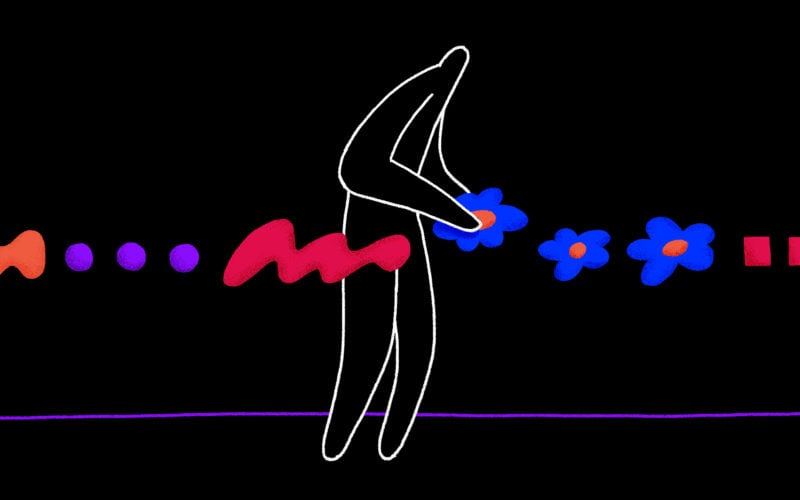Illustration: Jocelyn Tsaih
When a creative spark hits us that compels us to create music, the idea is almost never a complete song.
Rather, it’s often a smaller seed—maybe a melody or groove that’s just a few measures long. From there, we have to expand upon this seed to grow it into a complete song that we can call a finished product. But how exactly do we do that?
Song structure, or song form, is what allows us to take our individual ideas and turn them into complete compositions. In this article, we’ll discuss some song forms and sections that are seen across all sorts of genres and styles, with a particular emphasis on popular music (no sonatas or fugues for today, as lovely as they are).
See our table of contents below to quickly navigate to a specific section.
What you’ll learn:
- What is song structure?
- Components of a song
- What is an intro?
- What is a verse?
- What is a chorus?
- What is a bridge?
- Other common song sections
- Song structure examples
- Song structure for beats and instrumental music
- Conclusion
Feeling ready? Let’s dive in!
What is song structure?
Song structure describes the arrangement of the parts of a song. It’s what allows us to shape a piece of music with sections that are sequenced and organized in a familiar manner, and can also provide us with some compositional ideas around how we can write unique—but related—additional parts to our song.
If a song consisted of a string of ideas that never recurred in any way, no matter how interesting each idea is, the composition as a whole might leave us scratching our heads. This is because one of the aspects that makes a lot of music so enjoyable is the balance between exciting surprises and fulfilled expectations—and song structure helps us fulfill the latter.
Components of a song
We’ll dive into popular song structures a bit later, but first, we need to understand the individual sections that constitute them. Here are some of the most popular components in the song structures of today:
- Introduction (intro)
- Verse
- Chorus
- Bridge
If you have some vocabulary around music, you might already be familiar with some or all of these sections, even if you’ve never written your own songs before. That said, we’ll dive deeper into each of these below, with a focus on how you might approach them from a compositional perspective as well.
What is an intro in a song?
An intro pretty much defines itself—it’s the section that introduces us to the song. Often, an intro is instrumental. For example, let’s take a listen to the Foo Fighters classic, “Everlong:”
Here, the first 30 seconds of the song (up until the vocals kick in) can be labeled as the intro. While the name makes it seem like it only happens at the beginning of the song, the intro often establishes some sort of theme that’s used repeatedly throughout a composition; in the case of “Everlong,” we hear the same ideas from the intro continue underneath the vocals, and reappear to connect various other sections throughout the song as well.
How to write your own intro
Intros are a great way to set the tone of your song, while providing an opportunity for the instruments to shine and the vocals to breathe (if you have a track that’s primarily vocal-driven). That said, intros can definitely feature vocals as well.
Although there are no hard rules, the following points might be good to keep in mind when writing an intro:
- Make it count: We live in an era where people’s attention spans are short and the skip button is always at our fingertips. With this in mind, make sure your intro has a selling point that grabs your listeners’ attention, whether it’s catchiness, emotion, energy, a unique sound, etc.
- Consider using it to foreshadow: The melodies, chords, rhythms, etc. in your intro can be completely unique from the rest of your song. However, you can also use the section as a way to foreshadow some other moment(s) in your track and further tie things together, as “Everlong” does. Whether it’s a synth melody that references a vocal line that appears later on or a drum groove that continues into the next section of the track, don’t be afraid to recycle existing material to write your intro.
- Don’t feel the need to write it first: Many essayists recommend writing your introduction last, after you’ve gained perspective on the direction of the complete piece; intros in music are no different. While it might naturally be that first seed that sparks the rest of your composition, if your starting point is a different part of the song, don’t let it be a blocker in your songwriting.
An optional element (in today’s pop in particular)
We’ll get into how to sequence our sections once we’ve defined all of them, but it’s worth noting here that a lot of contemporary popular music is about conciseness and maximum efficiency, and for this reason, intros can often be shaved down to a few measures or even omitted entirely.
For example, Halsey’s “Graveyard” plays through a looping acoustic guitar chord progression just once for its intro, before her vocals kick in for the verse five seconds into the song:
And for a song that completely does away with an intro, take a listen to Maggie Rogers’ “Light On:”
What is a verse in a song?
Verses are the parts of a song where lyrically, the details of the narrative often unfold. Instrumentally, it’s a section that’s typically a little more sparse or subdued (compared to latter sections we’ll explore like the chorus).
In the case of Kendrick Lamar’s “HUMBLE.,” the verses would be from 0:07 – 0:58 and 1:24 – 2:15:
And in Rihanna’s timeless hit “Umbrella,” the verses are the parts from 0:32 – 0:54 and 1:39 – 2:01:
How to write your own verse
While verses are incredibly versatile and diverse, here are some tips that might help you get started:
- Tell a story: As mentioned earlier, the verse is often where the narrative unfolds. For this reason, it’s a section where the lyrics often change entirely in the event that it’s repeated (as heard above). Use verses as a way to tell a story, especially for tracks where lyrics are involved.
- Save some drama: Verses are rarely the emotional climax of a track. Especially when it comes to arrangement, try to save some of the ‘wow factor’—maybe the guitars are palm muted instead of playing open chords, the drum groove is just using the kick and snare rather than the whole kit, the keyboard part cuts out, etc. The range for the main melody is also often smaller, not hitting the highest points in the song.
- Sweat the details: That said, don’t write off the verse as an unimportant section. In many popular song forms, they’re among the most repeated sections, so get creative on how you can make them engaging, without needing to go ‘all out’ (an exception to this is in rap, where often times the verses can become the highlights of the track).
What is a chorus in music?
In contrast to the verse, the chorus is the big payoff of the song – the part that most people will remember. Lyrically, it’s typically more thematic or emotion-based, boiling down the core message of the song in a way that’s perhaps less narrative than the verse. Musically, it’s usually louder and more full in arrangement, and might use a larger melodic range.
A classic example of a cathartic chorus is Queen’s “We Are The Champions,” where the chorus occurs at 0:39 – 1:11, and again from 1:55 – 3:09:
In BTS’ “Dynamite,” the chorus occurs at 0:42 – 0:58, 1:33 – 1:49, and 2:23 – 3:14. A brief excerpt of it is also cleverly used as the intro:
How to write your own chorus
Here are some tips you might want to consider when tackling your chorus:
- Focus on memorability: The chorus is the selling point to your song, both figuratively and literally (in the event that you choose to release your music). Pull all the stops for your chorus and really try to create something that’s catchy, emotive, and compelling. Consider changing the chord progression from the verse if it helps the chorus stand out (although plenty of songs keep it the same).
- Go out with a bang: Generally speaking, the choruses are likely to be more consistent than the verses, with changes in lyrics being sparse with each repetition (if there are any at all). That said, people often try to change things up, especially during the last chorus, to really go out with a bang. Consider making the final chorus special in some way, whether it’s by doubling the duration, briefly stripping things down, adding new instrumental layers, making it reach higher notes, raising its key, etc. (the BTS example above somehow does all of these things).
- Make sure it can hold its ground: Make sure your chorus can stand on its own and still feel satisfying. When people are previewing music, they’ll often scrub for the chorus, so you want to make sure it feels like the destination, rather than a section that’s passive or meant to lead into something else. If someone listens to this section and is unsure whether it was the chorus, that’s usually an indicator that there’s more work to be done.
Alternative options to keep in mind
While we’ve been breaking down broad trends (within the specific lens of Western popular music) and making recommendations based on them thus far, we can’t stress enough that there are no rules to making music. As proof of this, several variations on the traditional chorus have penetrated the mainstream and become archetypes of their own. We highlight two of these alternatives below, to give you some ideas around how you might also change things up.
The first is what’s colloquially known as ‘the drop,’ an instrumental section most often found in EDM and its various sub-genres in place of the chorus. An example of a drop that completely took over radio stations in 2016 is the one in The Chainsmokers’ “Closer,” which occurs from 1:10 – 1:30, 2:31 – 2:51, and 3:32 – 3:52.
The second alternative that’s becoming increasingly popular is the ‘anti-chorus’ or ‘anti-drop.’ Over years of conditioning, we’ve grown to expect the chorus to be the loudest or most intense section of a song. The anti-chorus plays on this, catching us by surprise by making the chorus more stripped-down or bare in comparison to the preceding section. An example of an effective anti-chorus can be heard in Charlie Puth’s “Attention,” which hits at 0:48 with just a thumping bass guitar accompanying his vocals:
What is a bridge in music?
The last section we’ll discuss in detail is the bridge, a section that can sometimes be a secondary emotional climax to the chorus, although it doesn’t typically quite have the same the ability to stand on its own. The bridge represents a turning point, often both lyrically and musically. In the lyrics, there’s often some sort of revelation or realization. In the instrumentation, the arrangement or harmony might take a new turn. More often than not, it’s the section that connects the song to the final chorus, hence the name.
An example of a bridge that rivals the emotional drama of the chorus is the one heard between 2:02 – 2:21 in Linkin Park’s 2003 hit “Numb:”
There are also plenty of subdued, more intimate bridges, as heard in 2:29 – 3:02 of The Weeknd’s “The Hills:”
How to write your own bridge
Bridges are great because they often break up the pattern of going back and forth between verses and choruses. When it comes to writing your own bridge, here are some ideas for how you can make it stand out from the rest of your track:
- Try experimenting with the harmony: Many bridges make themselves feel different from the rest of the song by changing up the harmonic structure, either by going to a different key or simply starting with a chord that’s not the tonic chord (IV in a major key, or VI in a minor key, are common choices).
- Think about contrast across all elements: In addition to harmony, consider experimenting with rhythms, melodies, instrumental arrangements, and lyrics that contrast with the other sections of the song.
- Lean into vulnerability: Whether it’s a singer-songwriter ballad or an instrumental beat, bridges are often emotionally expressive and impactful. What is the song really trying to convey? What melody will pique the listener’s interest in a new way? Don’t hesitate to lean into vulnerability when you’re putting together a bridge.
For more on writing great bridges, be sure to also check out our dedicated guide on the section:
Other common song sections
While we’ve covered some of the most omnipresent sections above, there are also countless other sections that are seen quite often. Before we move on to popular song forms, we’ll mention a few more here in rapid-fire fashion.
What is a pre-chorus?
Pre-choruses are sections that precede the chorus, typically smoothening the transition in intensity from the verse. They often feature a brief switch-up in tone—like bridges, they often start on a chord such as IV in a major key, or VI in a minor key.
Check out 0:44 – 0:59 of Adele’s “Set Fire to the Rain” for a quality pre-chorus:
What is a post-chorus?
Some songs that want to tack additional ideas onto their chorus will have a post-chorus that connects it to the next section. Post-choruses can actually be some of the catchiest parts of songs—take the post-chorus heard from 1:10 – 1:29 and 2:30 – 2:49 of Ed Sheeran’s “Shape of You,” for example. The section feels distinctive from the chorus that it precedes, but plays on the material found in it:
What is a solo?
If we want a section that lets one instrument have a few measures where it’s distinctly featured, we give it a solo. Solos can be simple, instrumental renditions of existing elements from the song, or they can be incredibly technical and virtuosic, particularly in genres such as metal and jazz.
Take a listen to 2:05 – 2:34 and 4:32 – 6:22 of Pink Floyd’s “Comfortably Numb” for two great guitar solos (the latter doubles as an outro, a section we’ll get to next):
What is an outro / coda?
Outros are a lot like intros, but they help us ride out the very end of our song. 5:07 – 5:50 of Porter Robinson’s “Sad Machine” gently ties a bow on the track, while building off of a synth line that’s a key ingredient of the composition:
Song structure examples
Now that we’ve familiarized ourselves with individual song sections, we can start to think about how they’re combined to create different song structures / song forms. When musicians map out their songs, they often assign letter names (ex. A, B, etc.) to different sections to help easily articulate the overall journey. Over the course of millions and millions of songs, the world of Western popular music has naturally generated a few of these alphabetically-labeled patterns that are particularly common. Let’s explore a few below.
1. ABABCB (“verse-chorus-verse-chorus-bridge-chorus”)
ABABCB is perhaps the single most common song structure used in modern commercial music, appearing in genres spanning pop, R&B, rock, and more. In practice, it translates to “verse-chorus-verse-chorus-bridge-chorus.”
Out of the songs we explored today, “Everlong,” “Light On,” “Numb,” “The Hills,” “Set Fire to the Rain,” and “Shape of You” all follow this structure on a macro level, demonstrating just how ubiquitous it is. Once you zoom in on each, you’ll find that there are some variations: a pre-chorus on one song, a post-chorus in another, a few additional measures here and there, etc. However, if you package the pre-choruses with the verses and the post-choruses with the choruses (as people regularly do when discussing high-level song form), you’ll find that at their core they follow this same ABABCB flow.
ABABCB is a great song structure to use in your own compositions if you want something that’s familiar and tested. It’s very much a ‘don’t-fix-what-isn’t-broken’ form, and there’s no shame in reaching for it; it’s popular for a reason. An easy way to boost it is to double the duration of the B section at the end, not deviating from the main spirit but doubling the final chorus for extra effect.
2. ABAB (“verse-chorus-verse-chorus”)
ABAB form is simple and sweet, relying on the oscillation between two contrasting parts to drive the song. Despite sounding quite different in their application, “HUMBLE.” and “We Are The Champions,” both rely on this song structure, with the latter doubling the second B section to drive the anthemic spirit home. This is a song form that’s as old as time, and is great for lyrical music as well as instrumental music.
3. ABABC (“verse-chorus-verse-chorus-new section”)
If you want to get a little more experimental, one other option is to consider bringing in a completely new section at the end of a song to surprise your listeners. The form that precedes it can vary, but is usually somewhat straightforward (like ABAB, for instance).
An example of a song that makes an effective use of this sort of song structure is The Beatles’ “Hey Jude.” The song starts off with a relatively straightforward pattern that alternates between verses and choruses, but then brings in the famous “Na na na” section for the second half of the song, which is only hinted at very briefly until that point.
Now of course, there are tons of additional variations out there. That said, these song structures should give you a solid starting point if you don’t know where to take your track.
Song structure for beats and instrumental music
While the sections we explored today also translate seamlessly to instrumental music, it can’t be denied that they’re driven by vocals more often than not. Many of us who are just starting out with music production may be making beats or instrumental demoes, rather than full-fledged arrangements with vocals (or, perhaps instrumental music is simply your area of interest).
If this is you, here are some additional techniques that might be helpful when it comes to expanding an idea into a full track, outside of the traditional conventions of verses, choruses, etc.
Textural variations
Even in instrumental music, you often have tons of individual layers going on at once: the kick, snare, hi-hat, bass, keys, synths, etc. Without composing entirely new material, you can often create an effective contrasting section by simply removing some of these elements; perhaps you keep the same kick and snare patterns, but mute the hi-hats and the bass, for example. Then, when you reintroduce these elements later, they’ll sound exciting thanks to the power of contrast.
Daft Punk’s “Around the World” effectively demonstrates this sort of technique—the track doesn’t really follow a traditional verse-chorus song structure, but is rather essentially a loop of just one core idea. Despite that, it’s still engaging for its full duration because the duo cleverly remove and introduce layers that create regular changes to the overall musical texture and energy.
Rhythmic variations
Another simple technique for expanding upon an idea is switching up the rhythmic pulse. In one section, perhaps your snare and other rhythmic accents are landing on the second and fourth beats of each measure, as they often do. To easily introduce a new feel, you could keep the same melodies, chords, etc. but cut the frequency of these hits in half—making them land on just the third beat of every measure instead.
This is a popular trick in rock music in particular. While it’s not an instrumental track, take the last chorus in Fall Out Boy’s “The Phoenix” for example—the same material is repeated twice, with the rhythmic pulse slowed down (to what’s known as half time) the second time around at 3:41. This simple change gives a whole new feel to the chorus, and helps create a new musical moment with relative ease.
Timbral variations
Lastly, one simple way to add variation is to simply change up the instruments that are playing a particular part. If the melody is being played by a synth during one section, perhaps try switching it up to be played by a keyboard in the next. Even if the melody doesn’t change, the contrast in the timbre can make all the difference and pique a listener’s interest. This is how a seven-minute track like “We Are The World” works; the melodies don’t change, but each new voice—and the unique interpretation it brings to the melody—keeps us engaged.
The song also changes key several times, which is another easy way to create musical interest without writing entirely new sections. While extremely effective, key changes can sound a little cheesy (especially in today’s musical landscape), so do use them with intentionality.
Wrapping up our guide to song structure
As we did extensively in today’s article, the best way to learn about song structure is to learn directly from the music that you enjoy most. Whether it’s vocal-driven or instrumental, you’ll start to pick up on some patterns and techniques that you can gradually incorporate into your own work. Consider starting off with shorter tracks, and then increase the duration and scope of your music little by little as you become more comfortable (or, give a try at creating an epic 10-minute project from the start if that feels more fun for you—whatever inspires you the most)!
If you’re reading this article as part of your journey towards creating your first track, go back to the curriculum that corresponds with your DAW and proceed to the next step:
September 29, 2023



